Global Point of Care



All about the flu
The flu, or influenza, is a respiratory virus we tend to think of as a cold-weather infection. It can peak between December and February but respiratory flu is actually a year-round virus, and a contagious one at that. The good news is that a rapid flu test can help you or your family members get the right treatment sooner and help keep you from spreading it to others.1,2
Need to find a test provider or buy a COVID-19/Flu combo self test to conduct at home
RECOGNIZING SYMPTOMS OF the FLU
You know that uncomfortable feeling from fever, chills, aches, coughing, a runny nose. You’re exhausted and all those symptoms won’t let you rest. Sure, they’re classic flu symptoms, but they’re also classic indicators of a few other respiratory illnesses, like COVID-19, strep throat, and RSV.
Instead of assuming that flu is the culprit, find a test provider or buy a self test for COVID-19/flu as soon as symptoms appear. A rapid test will help identify what the underlying cause so you can start the right treatment sooner.
Click here to learn more about different types of rapid tests.
Common symptoms of the flu
- Fever or chills
- Sore throat
- Cough
- Runny nose
- Congestion or stuffy nose
- Headache
- Muscle or body aches or pains.
- Feeling tired
If you or someone close to you has flu-like symptoms, rapid tests can provide accurate diagnosis, possibly leading to appropriate treatments more quickly.
Learn more about the flu and how rapid tests can identify the virus, leading to the right treatment sooner.

SUCCESSFUL FLU TREATMENT STARTS WITH AN EARLY DIAGNOSIS3
Antiviral medicines treat respiratory flu. They work best, however, when you start taking them just after flu symptoms appear.3 So, when you feel symptomatic, the sooner you get rapid testing, the sooner you’ll get an accurate diagnosis and can start the right treatment to feel better.
Here’s why rapid testing matters:
If you start taking antivirals within two days of feeling symptoms, there’s evidence you can feel better quicker. 3
Given that antivirals work best when they’re both prescribed and taken quickly, getting a rapid flu test once you have symptoms is recommended. It gives your clinician the most accurate information in a short window of time so that a treatment decision can be made early to get you feeling better sooner.1,3
Take a rapid test within the first 48-hours of experiencing symptoms, especially if you have a high fever and upper respiratory symptoms.


WHAT YOU SHOULD KNOW ABOUT POTENTIAL
FLU COMPLICATIONS
There’s no doubt that having the flu is uncomfortable. For many of us, it’s a few days of feeling under the weather.4,5 But it’s not uncommon for some to feel tired and weak for up to several weeks following the initial infection.6 However, people with underlying health conditions like asthma, diabetes, and heart disease—or children younger than 5, older than 65, or who are pregnant—can have complications from the flu.2 They need to be seen by a clinician and treated quickly.
Here’s what you should look out for:
Pneumonia
- Pneumonia can be caused directly by the flu virus. It can also be the result of the body’s weakened immune system. For some people, that can make it hard to fend off bacteria that leads to pneumonia.4
- Pneumonia can, in general, cause over a million hospitalizations in the U.S. annually.7
Other serious complications
- Inflammation: This can cause swelling, including of the heart, brain, or muscle tissues.4
- Multi-organ failure: An example could be simultaneous lung and kidney failure.4
- Sepsis: This is an extreme reaction to an infection, like the flu, that can damage vital organs and can cause death.
Impact on people with chronic diseases
- If you have asthma: Even if it’s well controlled, you could have more asthma attacks with the flu.
- If you have heart disease: You are at a higher risk of having serious flu complications. Flu could also increase the risk of heart attacks and strokes.8
- If you have diabetes: Your blood sugar may be harder to control when you have the flu.8
- If you have chronic kidney disease: You may have both a harder time fighting the flu and be at greater risk of serious illness from the infection.8
- Because of all these potential complications, it’s critical to get rapid flu testing as soon as you experience symptoms so you can get the diagnosis and appropriate treatment as quickly as possible.
THE BASICS TO HELP PREVENT CATCHING OR SPREADING THE FLU
There are steps you can take to help avoid catching or spreading the flu.
- Wash your hands often
- Keep your hands off face
- Avoid close contact with those infected
- Cover coughs and sneezes
- Clean and disinfect surfaces
- Stay home when you are sick.
READ MORE ABOUT RAPID Testing

BINAXNOW™. KNOW NOW
During the early stages of the pandemic, we helped pioneer the technology used on the frontlines to test for COVID-19. Now that same technology is available to you in a convenient at-home self test. You can choose between testing for COVID-19 only or COVID-19 and Flu combined.

ALL ABOUT RESPIRATORY ILLNESSES
Learn about respiratory illnesses and the newer advanced test technology that offers fast and accurate results. Knowing now means you’ll be treated earlier which can help you get well sooner.

FIND THE BEST TEST FOR YOU
Rapid tests are essential tools to help diagnose what’s behind your symptoms, so you can treat earlier and get well sooner. Understand the differences between rapid molecular tests and at home COVID-19 antigen self tests.
REFERENCES
- Uyeki, Timothy M., et al. “Clinical Practice Guidelines by the Infectious Diseases Society of America: 2018 Update on Diagnosis, Treatment, Chemoprophylaxis, and Institutional Outbreak Management of Seasonal lnfluenza,” Clinical Infectious Diseases 68, no. 6 (March 5, 2019): Pages e1- e47. https://academic.oup.com/cid/article/68/6/e1/5251935
- Marwan M. Azar, Marie L Landry, “Detection of lnfluenza A and B Viruses and Respiratory Syncytial Virus by Use of Clinical Laboratory Improvement Amendments of 1988 (CLIA)-Waived Point-of-Care Assays: A Paradigm Shift to Molecular Tests,” Journal of Clinical Microbiology Vol. 56, no. 7 (June 25, 2018). https://journals.asm.org/doi/10.1128/jcm.00367-18
- “What You Should Know About Flu Antiviral Drugs.” Centers for Disease Control and Prevention (CDC). Last updated May 2024. https://www.cdc.gov/flu/antivirals/whatyoushould.htm
- “Flu Symptoms & Complications,” Centers for Disease Control and Prevention (CDC), Last updated July 2024. https://www.cdc.gov/flu/symptoms/symptoms.htm
- “lnfluenza (flu)” Mayo Clinic, Accessed August 28, 2024. https://www.mayoclinic.org/diseases-conditions/flu/diagnosis-treatment/ drc-20351725
- Hall, Elisha. “Influenza.” Epidemiology and Prevention of Vaccine-Preventable Diseases, 14th Edition, edited by Elisha Hall, et al, pages 179-192, Washington, D.C. Public Health Foundation, 2021. https://www.merle-arbeitsmedizin.de/wp-content/uploads/2022/02/CDC-Pink-Book-Version-14th-Edition.pdf
- “Trends in Pneumonia and Influenza Morbidity and Mortality.” American Lung Association. November 2015. https://www.lung.org/getmedia/98f088b5-3fd7-4c43-a490-ba8f4747bd4d/pi-trend-report.pdf.pdf
- “A Chronic Health Condition Can Increase Your Risk,” Centers for Disease Control and Prevention (CDC). Last reviewed September 7, 2022. https://www.cdc.gov/flu/highrisk/chronic-conditions/index.htm





